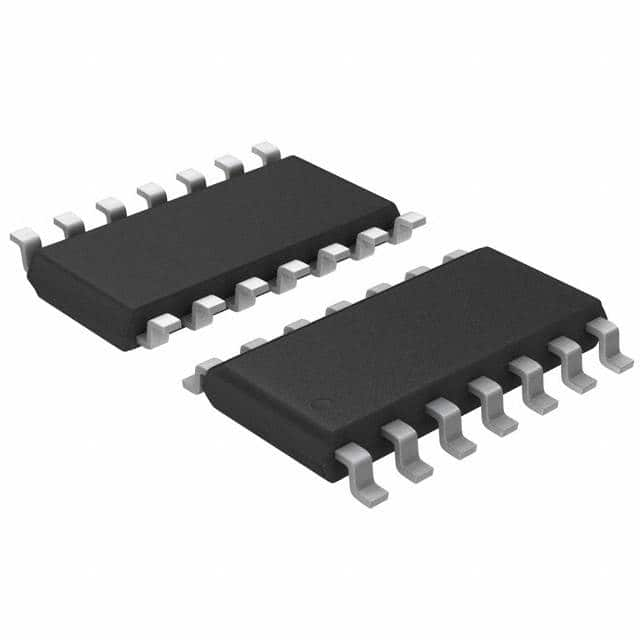Consulte las especificaciones para obtener detalles del producto.

MAX3086ESD+T
Product Overview
- Category: Integrated Circuit
- Use: Transceiver
- Characteristics: High-speed, Low-power, RS-485/RS-422 Interface
- Package: 14-Pin SOIC (Small Outline Integrated Circuit)
- Essence: MAX3086ESD+T is a high-speed transceiver IC designed for RS-485 and RS-422 communication interfaces.
- Packaging/Quantity: Available in tape and reel packaging with 2500 units per reel.
Specifications
- Supply Voltage Range: +4.75V to +5.25V
- Data Rate: Up to 20Mbps
- Operating Temperature Range: -40°C to +85°C
- Number of Channels: 1
- Input Resistance: 12kΩ
- Output Resistance: 96Ω
- ESD Protection: ±15kV Human Body Model (HBM)
Pin Configuration
The MAX3086ESD+T has a 14-pin SOIC package with the following pin configuration:
- DE (Driver Enable)
- RE (Receiver Enable)
- A (Non-Inverting Driver Output / Receiver Input)
- B (Inverting Driver Output / Receiver Input)
- GND (Ground)
- Y (Receiver Output)
- VCC (Power Supply)
- Z (Driver Output)
- B (Inverting Driver Output / Receiver Input)
- A (Non-Inverting Driver Output / Receiver Input)
- RE (Receiver Enable)
- DE (Driver Enable)
- GND (Ground)
- VCC (Power Supply)
Functional Features
- High-speed data transmission up to 20Mbps.
- Supports both RS-485 and RS-422 communication standards.
- Low power consumption for energy-efficient operation.
- Built-in ESD protection for enhanced reliability.
- Driver and receiver enable pins for flexible control.
Advantages
- Wide supply voltage range allows for compatibility with various systems.
- High data rate enables fast and efficient communication.
- Low power consumption reduces energy costs.
- ESD protection ensures robustness against electrostatic discharge.
- Driver and receiver enable pins offer flexibility in controlling the transceiver.
Disadvantages
- Limited to a single channel, limiting simultaneous communication on multiple channels.
- Requires external components for complete system integration.
Working Principles
The MAX3086ESD+T is designed to facilitate bidirectional communication between RS-485/RS-422 devices. It utilizes differential signaling to transmit and receive data over long distances while maintaining noise immunity. The driver section converts logic-level signals into balanced differential voltages, while the receiver section converts the received differential signals back into logic-level signals.
Detailed Application Field Plans
The MAX3086ESD+T finds applications in various fields, including:
- Industrial Automation: Used for communication between PLCs (Programmable Logic Controllers), sensors, and actuators in industrial automation systems.
- Building Automation: Enables communication between different building management systems, such as HVAC (Heating, Ventilation, and Air Conditioning) and lighting control systems.
- Automotive: Utilized in automotive electronics for communication between different vehicle subsystems, such as engine control units and body control modules.
- Telecommunications: Facilitates data transmission in telecommunications equipment, including modems, routers, and switches.
- Security Systems: Enables communication between security devices, such as access control systems, CCTV cameras, and alarm panels.
Detailed and Complete Alternative Models
- SN65HVD1787DGGR: A similar high-speed RS-485 transceiver from Texas Instruments.
- LTC2850IMS8#PBF: Low-power RS-485 transceiver from Linear Technology.
- ADM2485BRWZ: RS-485/RS-422 transceiver with integrated isolation from Analog Devices.
- SP3485EN-L/TR: Low-power half-duplex RS-485 transceiver from Exar Corporation.
- ST485BDR: RS-485 transceiver with low power consumption from STMicroelectronics.
These alternative models offer similar functionality and can be considered as alternatives to the MAX3086ESD+T.
In conclusion, the MAX3086ESD+T is a high-speed transceiver IC designed for RS-485 and RS-422 communication interfaces. It offers various advantages such as high data rate, low power consumption, and built-in ESD protection. With its wide range of applications and availability of alternative models, the MAX3086ESD+T is a versatile choice for reliable and efficient communication in diverse fields.
Enumere 10 preguntas y respuestas comunes relacionadas con la aplicación de MAX3086ESD+T en soluciones técnicas
Sure! Here are 10 common questions and answers related to the application of MAX3086ESD+T in technical solutions:
Question: What is MAX3086ESD+T?
- Answer: MAX3086ESD+T is a high-speed, low-power transceiver designed for RS-485 and RS-422 communication applications.Question: What is the operating voltage range of MAX3086ESD+T?
- Answer: The operating voltage range of MAX3086ESD+T is from 3V to 5.5V.Question: Can MAX3086ESD+T be used for half-duplex communication?
- Answer: Yes, MAX3086ESD+T can be used for both half-duplex and full-duplex communication.Question: What is the maximum data rate supported by MAX3086ESD+T?
- Answer: MAX3086ESD+T supports data rates up to 20Mbps.Question: Does MAX3086ESD+T have built-in ESD protection?
- Answer: Yes, MAX3086ESD+T has ±15kV ESD protection on the RS-485/RS-422 bus pins.Question: Can MAX3086ESD+T operate in harsh industrial environments?
- Answer: Yes, MAX3086ESD+T is designed to operate in harsh industrial environments with its wide temperature range and robust features.Question: How many receivers can be connected to MAX3086ESD+T?
- Answer: MAX3086ESD+T can support up to 256 receivers on the bus.Question: Is MAX3086ESD+T compatible with other RS-485 transceivers?
- Answer: Yes, MAX3086ESD+T is compatible with other RS-485 transceivers and can be used in multi-vendor systems.Question: Can MAX3086ESD+T be powered from a single supply voltage?
- Answer: Yes, MAX3086ESD+T can be powered from a single supply voltage, simplifying the design.Question: Are evaluation kits available for MAX3086ESD+T?
- Answer: Yes, evaluation kits are available to help developers quickly prototype and test their designs using MAX3086ESD+T.
Please note that these answers are general and may vary depending on specific application requirements. It's always recommended to refer to the datasheet and consult the manufacturer for detailed information.

